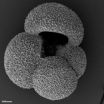More intensive methods needed to identify TB in HIV-prone populations
2011-01-15
(Press-News.org) Identifying tuberculosis patients in Africa using passive methods is leaving many cases undiagnosed, according to researchers from the Netherlands, Kenya and the United States, who studied case detection methods in HIV-prone western Kenya. Tuberculosis (TB) occurs commonly in men and women with HIV, but in these patients TB can be more difficult to detect.
The findings were published online ahead of the print edition of the American Thoracic Society's American Journal of Respiratory and Critical Care Medicine.
"Limited information exists on the prevalence of tuberculosis and the best methods of identifying TB patients in African populations with high rates of HIV," said study author Anja van't Hoog, MD, MSc, physician-researcher and epidemiologist, Academic Medical Centre, University of Amsterdam. "In this study, our goals were to estimate how many individuals have TB confirmed by bacteriological testing and the number of cases which occur along with HIV, as well as to evaluate case detection."
In passive detection, which has been the method predominantly used in Kenya and globally since the 1970s, diagnoses are made only after patients present to health clinics and report a prolonged period of coughing. Dr. van't Hoog, who conducted the study while serving as an epidemiologist at the Kenya Medical Research Institute, said more aggressive, intensive methods of detection are needed to help identify more cases, and identify them earlier.
"Previous studies have suggested that passive case finding might be adequate for TB control," she noted. "However, TB epidemiology has changed dramatically as a result of the HIV epidemic, and there is little information available regarding the prevalence of tuberculosis and the effectiveness of case-finding in African populations with high rates of TB and HIV. "
The researchers recruited 20,566 adults from 40 randomly sampled village clusters in a rural area of western Kenya and collected two sputum samples from each adult. Samples were evaluated using a smear microcopy test. Participants also were given questionnaires about their exposure to TB and nearly all participants agreed to undergo a chest X-ray. Those with abnormal X-ray findings or symptoms suggesting TB each provided an additional sputum sample for examination by sputum culture, a testing method which is much more sensitive than smear microscopy.
Following evaluation, 123 participants were identified as having tuberculosis. TB prevalence was greater among men, those who had received prior TB treatment and those in the lowest socioeconomic level. HIV information was available for 101 of the 123 TB-positive participants, of whom 51 percent were identified as being infected with HIV. The researchers estimated 48 percent of the undiagnosed burden of TB in the population is due to HIV.
Diagnosing TB earlier and more accurately can help prevent severe illness and death from TB, and reduce transmission of TB to other community members, Dr. van't Hoog said. Men and women with HIV infection are at much greater risk of getting TB, but the presentation of TB is more often atypical in patients with HIV, making diagnosis more difficult, she added.
"Most of the identified TB cases in this study would not have been identified by the current case detection approach, which includes symptom recognition, sputum smear microscopy and chest X-ray," Dr. van't Hoog noted. "Culturing sputum samples offers more accurate results, but is a more complicated, costlier procedure, making it largely unavailable in resource-limited settings.
"This study identified a considerable prevalence of infectious and largely undiagnosed pulmonary tuberculosis in western Kenya, where rates of HIV infection are high," she said. "The goals for TB control are unlikely to be met without continued improvements in case detection. Intensified case finding is required to control TB in this resource-limited, high HIV-prevalence setting, and future research should focus on ensuring these goals are met."
INFORMATION:
END
ELSE PRESS RELEASES FROM THIS DATE:
2011-01-15
DURHAM, NC and KING COUNTY, WA – An effort in King County, Washington, to add nutrition facts labeling to fast food menus had no effect on consumer behavior in its first year.
As part of a comprehensive effort to stem the rise in obesity, the county, which includes Seattle and environs, imposed a mandatory menu labeling regulation on all restaurant chains with 15 or more locations beginning in January, 2009. Restaurants had to disclose calorie information at the point of purchase.
Researchers from Duke-National University of Singapore (NUS) Graduate Medical School ...
2011-01-15
A simple, automated method of tracking E. coli uses a laser to detect and monitor the microbe in potentially contaminated bodies of water or waterways. The technique described this month in the International Journal of Computational Biology and Drug Design could reduce the incidence of waterborne disease outbreaks.
Microbial contamination of water is a worldwide environmental and health problem. Water related diseases are the leading causes of illness and death in the world. The impacts of water quality on public health and economy are highly significant as evidenced ...
2011-01-15
Wild red deer on the Isle of Rum, which were featured in the BBC TV series Autumnwatch, are rutting earlier in the year, a study shows.
Scientists believe the annual rutting season on the Isle of Rum could be changing because of warming spring and summer temperatures. The study shows that the rutting and calving seasons are now up to two weeks earlier on average compared with 30 years ago.
The research was based on a 38-year study of the ecology of red deer on the Isle of Rum and used annual records of breeding success in more than 3,000 individually recognisable ...
2011-01-15
The Estero de Domingo Rubio wetland, located near the Marismas del Odiel Natural Area in the Huelva estuary, is regionally, nationally and internationally protected thanks to its ecological value. However, its tributary rivers and the Ría de Huelva estuary pump manmade pollutants into it, which could affect its water quality and ecosystem.
Industrial activity, accumulations of dangerous waste, the expansion of farming, and excessive extraction of sand and gravel for the construction industry are the leading threats to the Estero de Domingo Rubio wetland, the tidal system ...
2011-01-15
The people in Spain at greatest risk of suffering farming accidents are those aged over 65, followed by people under 16 and people from outside the agricultural sector. These are the results of a study by the Public University of Navarre (UPNA), which shows that most of these deaths are due to people being crushed by tractors.
"Aside from recognised farming workers, other employees die in this sector and these deaths are not recorded. Our objective was to compare the real and official data on fatal farming accidents and to classify the most commonly associated risks", ...
2011-01-15
Eating blueberries can guard against high blood pressure, according to new research by the University of East Anglia (UEA) and Harvard University.
High blood pressure – or hypertension – is one of the major cardiovascular diseases worldwide. It leads to stroke and heart disease and costs more than $300 billion each year. Around a quarter of
the adult population is affected globally – including 10 million people in the UK and one in three US adults.
Published next month in the American Journal of Clinical Nutrition, the new findings show that bioactive compounds in ...
2011-01-15
The unusually cold weather this winter has been caused by a change in the winds.
Instead of the typical westerly winds warmed by Atlantic surface ocean currents, cold northerly Arctic winds are influencing much of Europe.
However, scientists have long suspected that far more severe and longer-lasting cold intervals have been caused by changes to the circulation of the warm Atlantic ocean currents themselves.
Now new research led by Cardiff University, with scientists in the UK and US, reveals that these ocean circulation changes may have been more dramatic than ...
2011-01-15
A woman passing by the window display is captivated and asks her companion "Isn't the leather bag chic?" "Which one do you mean? There are so many of them." The woman points to one of the bags and as if by magic the luxurious purse appears on a display behind the shop window. Then she points to a button and the designer object rotates on the screen. "So that's what it looks like from the back." The woman passing by is impressed. She makes another gesture to zoom the bag towards her letting her to see every detail.
This particular shopping experience is courtesy of new ...
2011-01-15
PITTSBURGH, Jan. 14 – A gene from the measles virus plays a key role in the development of Paget's disease of bone, according to a team of researchers led by the University of Pittsburgh School of Medicine. Their findings, recently published in Cell Metabolism, confirm a long-held speculation that the childhood infection is an environmental trigger for the disease and reveal how the viral gene contributes to the development of its characteristic bone lesions.
"Our earlier work showed that bone cells called osteoclasts in about 70 percent of these patients contain a certain ...
2011-01-15
The days are long gone when all you needed to be a truck driver was a heavy goods vehicle license and the ability to read a map. Nowadays it is a skilled occupation which requires lots of qualifications. Modern truck drivers have to operate electronic devices, adapt their routes expertly to the given traffic and loading situation, know how to drive fuel-efficiently, be up to date with statutory regulations and monitor the safety of their load. Then there is all the complex legislation introduced at EU level. What's more, drivers who make trips to other countries also need ...
LAST 30 PRESS RELEASES:
[Press-News.org] More intensive methods needed to identify TB in HIV-prone populations




